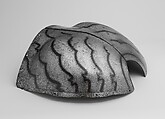Upper Part of a Crupper
Not on view
This upper part of a crupper comprises two large plates shaped to the horse's croup that are joined by several rivets over the spine, leaving an opening for the tail at the end. In its original form, it would have had one or more transverse plates elongating it at the front, as well as several large plates at the sides and rear that extended the defense downward to slightly below the level of the abdomen. Four threaded holes along the rather rough joint where the two plates overlap indicate that the joint was once covered by a tubular tail guard. The pairs of small holes (three on each plate around the embossed bulge over the point of the hip) are likely to have been for laces that served to secure a lining.
While the size and shape of the two surviving plates suggest a date in the second half of the sixteenth century, the decoration is unusual and defies conclusive identification. The surface is covered in parallel, scroll- or ribbonlike bands, now much corroded but each formerly damascned with gold and bordered along its upper edge with punched trefoils. The closest comparison both in motif and technique is found on a horse armor in Turin (Armeria Reale, B5) believed to have been made in Brescia about 1560 for a member of the Martinengo family of that city. Although the crupper of the Turin bard is constructed differently––its elongated, articulated plates are joined vertically––the main edge of each plate is decoratively cut, etched, and gilt so that it closely resembles the ribbonlike bands on the Museum's example. This similarity implies that the Museum's crupper is also of Brescian origin, although its punched and damascened decoration indicates a date later in the century or perhaps even in the early seventeenth century, when punched ornament in particualr was more customary.
Due to rights restrictions, this image cannot be enlarged, viewed at full screen, or downloaded.

